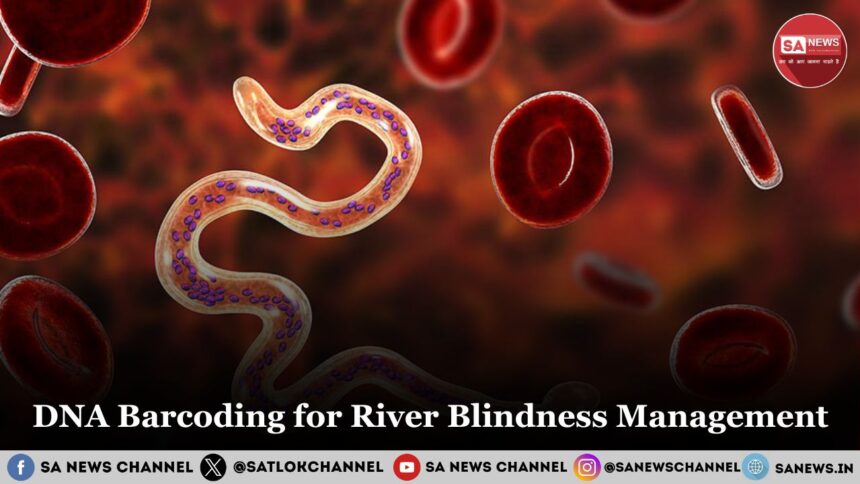Recent developments in the study of blackflies may have implications for the management of a serious parasitic disease called river blindness. A team from the Zoological Survey of India (ZSI) has published findings in an international journal, highlighting the importance of accurate species identification for effective disease control strategies.
About River Blindness
River blindness, or onchocerciasis, is caused by the parasitic worm Onchocerca volvulus. It spreads through the bite of infected blackflies that breed near fast-flowing rivers.
Symptoms include severe itching, skin rashes, nodules under the skin, and eventual blindness.
■ Also Read: RNA: The Blueprint of Life and Its Role in Modern Science
It is the second most common cause of infection-related blindness globally, after trachoma.
Role of the Blackfly
Blackflies, especially those from the Simuliidae family, are small but highly effective in spreading the parasite. Accurate identification of these species is vital. Out of over 2,400 known species, only a few are responsible for spreading O. volvulus.
DNA Barcoding Method
The ZSI team used DNA barcoding to identify blackfly species. This method involves:
- Extracting DNA from blackflies.
- Analyzing gene sequences to determine the species.
Four blackfly species were identified:
- Simulium dentatum
- Simulium digitatum
- Simulium praelargum
- Simulium senile
This technique offers higher accuracy than conventional visual methods. Platforms like the Barcode of Life Data Systems (BOLD) are instrumental in supporting such molecular taxonomy by providing a global repository of DNA barcodes for species identification.
Global Impact of Onchocerciasis
Onchocerciasis, or river blindness, predominantly affects rural populations in sub-Saharan Africa and Yemen. According to the World Health Organization (WHO), more than 249 million people required preventive treatment in 2023. WHO has documented significant progress in eliminating the disease in several countries, demonstrating that targeted intervention strategies—such as mass drug administration and vector control—can yield measurable success in reducing transmission and disease burden.
Treatment and Prevention Strategies
The primary treatment for onchocerciasis is ivermectin, which is distributed through Mass Drug Administration (MDA) programs led by public health authorities.
National onchocerciasis elimination committees have been formed to:
- Promote sustainable treatments.
- Implement vector control strategies.
- Monitor population-level outcomes.
Understanding Preventive Medicine
Unlike most medicines that treat symptoms, preventive medicine aims to stop diseases before they start—by preventing infections, reducing disability, and improving longevity.
What Is DNA Barcoding and How Is It Used?
DNA barcoding is a genetic method to identify species by analyzing a small, standardized DNA sequence (a “barcode”).
This tool:
- Matches unknown organisms to known species
- Accelerates the discovery of previously unidentified species
- Improves biodiversity tracking and ecological studies
Barcoding is also used commercially to identify and track products efficiently.
Spiritual Insight – Satgyan and Hidden Vision
Just as DNA barcoding reveals the true identity of tiny organisms, spiritual knowledge (Satgyan) reveals the hidden purpose of human life.
River blindness robs physical sight, but ignorance robs inner vision.
Sant Rampal Ji Maharaj teaches that by knowing the truth of creation and surrendering to the Supreme God, we gain eternal insight.
“As science uncovers microscopic truths, Satgyan reveals the ultimate one—our connection with the Creator.”
To learn more about true spiritual knowledge, visit: www.jagatgururampalji.org
FAQs
Q1. What is DNA barcoding used for?
Ans: To accurately identify known species and discover new ones by analyzing their genetic sequence.
Q2. What is the best treatment for river blindness?
Ans: Ivermectin, through mass drug administration programs.
Q3. How many blackfly species were identified in the ZSI study?
Ans: Four – S. dentatum, S. digitatum, S. praelargum, and S. senile.
Q4. Which regions are most affected by river blindness?
Ans: Sub-Saharan Africa and Yemen.
Q5. What makes DNA barcoding better than traditional methods?
Ans: It offers higher accuracy by using gene sequences, rather than visual identification.









